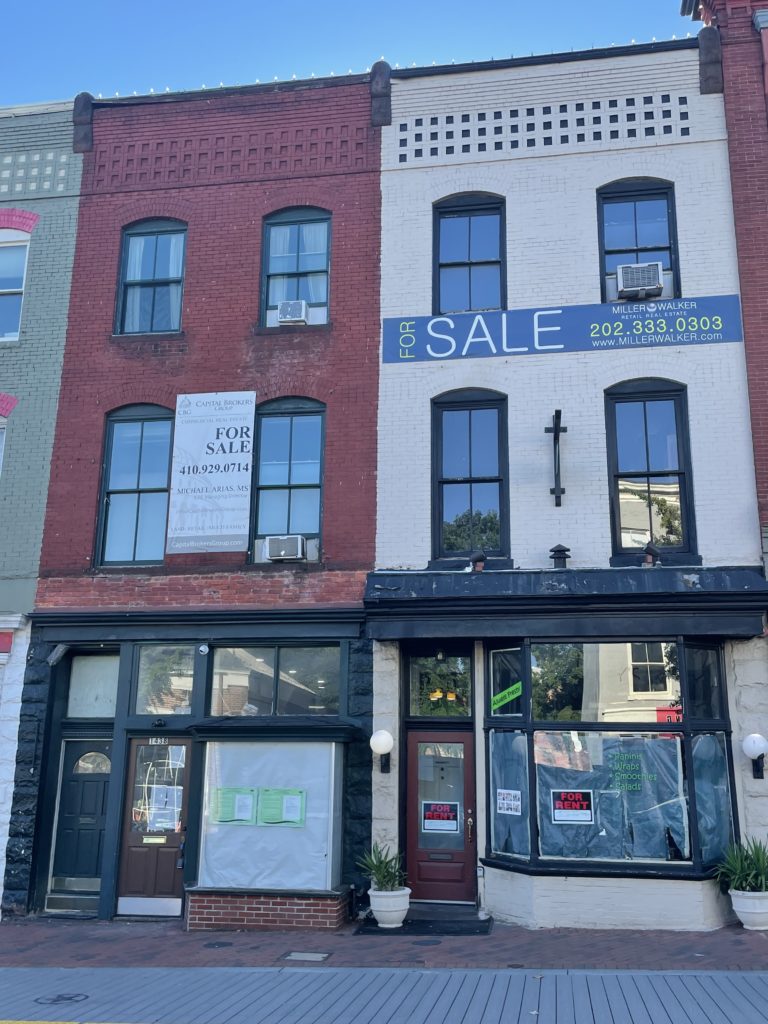
Many Georgetown residents are wondering – and worried – about all the empty storefronts in Georgetown. And there are indeed more than usual.
But first, let’s put that into context. The Georgetown commercial area has 2.1 million square feet of retail space and is the largest outdoor shopping district in the region. Only Tyson’s Corner Center is comparably as large. The commercial district includes about 508 retail and restaurant spaces, of which 446 are either currently occupied or about to be occupied. That means there are 62 vacancies, which equates to about a 12% vacancy rate. That compares to Georgetown’s historical vacancy rate of about 7%.
That leads to two questions: 1) why is the retail vacancy rate so much higher today? And 2) is the situation going to get better or worse?
The pandemic has been a significant reason for the increase in vacancies. Last year, when the pandemic in effect shut down the city, 64 Georgetown businesses closed. However, the vacancy rate was headed higher before the pandemic. Other key factors behind increased vacancy rates include:
- Online shopping has had a negative impact on brick-and-mortar sales;
- A spate of business bankruptcies of national brands (think Brooks Brothers) did damage;
- In tough times, tenants and building owners find it harder to find agreement on rents (Georgetown rents are some of the highest in the city);
- Empty storefronts sometimes beget more empty storefronts because they scare away potential new businesses; and
- Georgetown’s old, quirky historic buildings often require remodeling at significant expense to accommodate retail businesses.
All of those factors helped drive increased vacancy. But there is more good news than bad news when it comes to Georgetown’s retail and restaurant market. More than 40 new businesses have opened since the beginning of 2002, and 16 more are scheduled to open soon. Together that has dropped the vacancy rate from its Covid-driven high.
More good news. Through August 2021, there have been 7.7 million visits to Georgetown. That is about 80% of the number of visits that occurred during the same pre-Covid period in 2019 and is comparable to that of Tyson’s Corner. The recovery in Georgetown exceeds that of other DC commercial districts such as the 14th Street corridor, City Center, Union Market, The Wharf, and Capital Riverfront.
And there is good momentum building as we head into 2022. For example, it has been announced that Stephen Starr (he of Le Diplomat fame) will open an Italian restaurant and market in the former Dean & Deluca space. East Bank, which has a long successful track record with commercial development in Georgetown, will deliver a fully renovated building at Wisconsin Avenue and Prospect Street. Two new quick-service restaurants will open at Wisconsin and N Street, bringing more energy to that corner. More good news is likely to follow.
The Georgetown Business Improvement District (BID) does not control the real estate market. But it is doing its part to support this recovery. BID tells the story to retailers and restauranteurs why Georgetown is an excellent place to do business. It also provides property owners with information about market dynamics. Busy streets and sidewalks give retailers the confidence to open for business in Georgetown. Our efforts to support outdoor dining have made a big difference.
Public art experiences like Georgetown Glow, keeping public spaces clean and accessible, help attract people to shops and restaurants and support the long-term economic health of the neighborhood.
Here are the businesses that have opened so far this year:
- All About Burger
1424 Wisconsin Avenue
Burger restaurant - Amigo Mio
3057 M Street
Mexican restaurant - Budd & Co.
2824 Pennsylvania Avenue
Men’s apparel and accessories - Concept 31/M
3077 M Street
Market with apparel, accessories, and home goods - Donahue
1338 Wisconsin Avenue
Cocktail bar - Duly Noted
1355 Wisconsin Avenue
Paper goods store - Faherty
3263 M Street
Men’s and women’s apparel - Foxtrot
1267 Wisconsin Avenue
Market and café - Freshbee’s
2805 M Street
Quick-service American restaurant - Gong Cha Bubble Tea
3279 M Street
Bubble tea restaurant - Green Almond Pantry
3210 Grace Street
Mediterranean café and restaurant - High Road Cycling
3210 Grace Street
Cycling apparel and café - Priori Jewelry
1002 Wisconsin Avenue
Jeweler - Mason’s Famous Lobster Rolls
1078 Wisconsin Avenue
Lobster roll restaurant - Mini Me Little Boutique
3236 P Street
Children’s and women’s apparel - Prospect Optika
3252 Prospect Street
Eyeglasses retailer - Ray Ban
3030 M Street
Sunglasses retailer - Roll by Goodyear
1336 Wisconsin Avenue
Automobile tire sales and service - Sandlot Georgetown
2715 Pennsylvania Avenue
Outdoor bar and event venue - Sarah Flint pop-up
1079 1/2 Wisconsin Avenue
Women’s apparel
